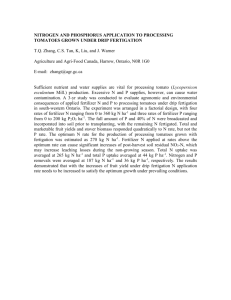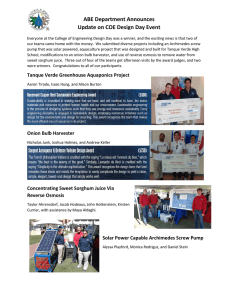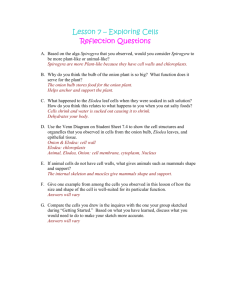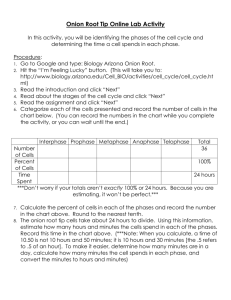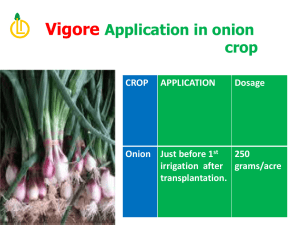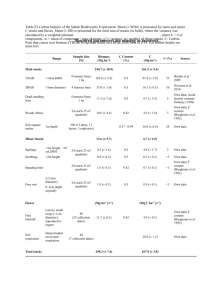Document 14094032
advertisement
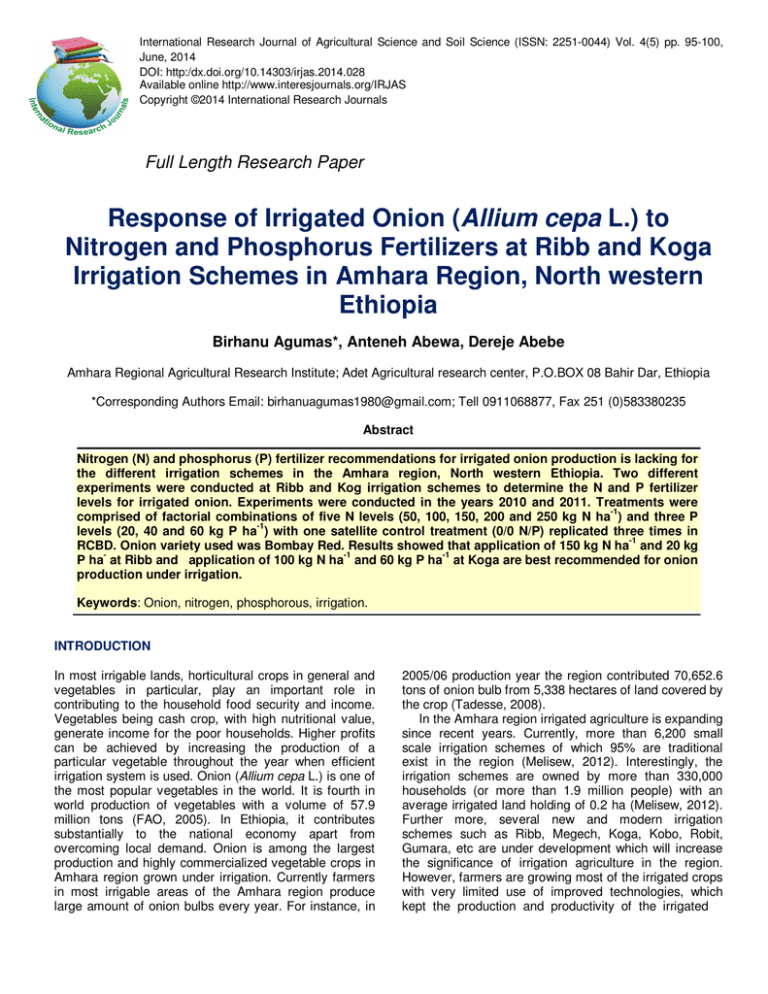
International Research Journal of Agricultural Science and Soil Science (ISSN: 2251-0044) Vol. 4(5) pp. 95-100, June, 2014 DOI: http:/dx.doi.org/10.14303/irjas.2014.028 Available online http://www.interesjournals.org/IRJAS Copyright ©2014 International Research Journals Full Length Research Paper Response of Irrigated Onion (Allium cepa L.) to Nitrogen and Phosphorus Fertilizers at Ribb and Koga Irrigation Schemes in Amhara Region, North western Ethiopia Birhanu Agumas*, Anteneh Abewa, Dereje Abebe Amhara Regional Agricultural Research Institute; Adet Agricultural research center, P.O.BOX 08 Bahir Dar, Ethiopia *Corresponding Authors Email: birhanuagumas1980@gmail.com; Tell 0911068877, Fax 251 (0)583380235 Abstract Nitrogen (N) and phosphorus (P) fertilizer recommendations for irrigated onion production is lacking for the different irrigation schemes in the Amhara region, North western Ethiopia. Two different experiments were conducted at Ribb and Kog irrigation schemes to determine the N and P fertilizer levels for irrigated onion. Experiments were conducted in the years 2010 and 2011. Treatments were comprised of factorial combinations of five N levels (50, 100, 150, 200 and 250 kg N ha-1) and three P levels (20, 40 and 60 kg P ha-1) with one satellite control treatment (0/0 N/P) replicated three times in -1 RCBD. Onion variety used was Bombay Red. Results showed that application of 150 kg N ha and 20 kg -1 -1 P ha at Ribb and application of 100 kg N ha and 60 kg P ha at Koga are best recommended for onion production under irrigation. Keywords: Onion, nitrogen, phosphorous, irrigation. INTRODUCTION In most irrigable lands, horticultural crops in general and vegetables in particular, play an important role in contributing to the household food security and income. Vegetables being cash crop, with high nutritional value, generate income for the poor households. Higher profits can be achieved by increasing the production of a particular vegetable throughout the year when efficient irrigation system is used. Onion (Allium cepa L.) is one of the most popular vegetables in the world. It is fourth in world production of vegetables with a volume of 57.9 million tons (FAO, 2005). In Ethiopia, it contributes substantially to the national economy apart from overcoming local demand. Onion is among the largest production and highly commercialized vegetable crops in Amhara region grown under irrigation. Currently farmers in most irrigable areas of the Amhara region produce large amount of onion bulbs every year. For instance, in 2005/06 production year the region contributed 70,652.6 tons of onion bulb from 5,338 hectares of land covered by the crop (Tadesse, 2008). In the Amhara region irrigated agriculture is expanding since recent years. Currently, more than 6,200 small scale irrigation schemes of which 95% are traditional exist in the region (Melisew, 2012). Interestingly, the irrigation schemes are owned by more than 330,000 households (or more than 1.9 million people) with an average irrigated land holding of 0.2 ha (Melisew, 2012). Further more, several new and modern irrigation schemes such as Ribb, Megech, Koga, Kobo, Robit, Gumara, etc are under development which will increase the significance of irrigation agriculture in the region. However, farmers are growing most of the irrigated crops with very limited use of improved technologies, which kept the production and productivity of the irrigated 96 Int. Res. J. Agric. Sci. Soil Sci. system not better than the rainfed system. For instance in Megech and Ribb areas, only 5 and 4 percent of the households that cultivated during the dry season using irrigation used chemical fertilizers and compost, respectively. The proportion is higher for households in the Megech project area (14% vs 4%) compared with Ribb area (World Bank/DIME, 2012). For the irrigated production system appropriate agronomic technologies have rarely been developed. Therefore, this experiment was conducted with the objective of determining the optimum rates of nitrogen and phosphorus fertilizers for onion production at Rib and Koga irrigation schemes in the region. MATERIALS AND METHODS Study Sites Experiments were conducted at Ribb and Koga irrigation schemes, north western Ethiopia, in the 2010 and 2011 production seasons. Ribb irrigation scheme is found in Fogera district situated at 110 41’ to 120 02’ N latitude and 370 29’ to 370 59’ E longitude at an altitude of 1800 m a.s.l. On the other hand Koga irrigation scheme is found in Mecha district situated at 11o25’20’’ N latitude and 37o10’20” E longitude at an altitude of 1960 m a.s.l. The soil at the Ribb experimental site is fluvisol (an alluvial deposit). According to Bruce and Rayment (1982), the soil has high phosphorus and very low to low total nitrogen contents (Table 1). At Rib the CEC is high according to the category by Pam Hazelton and Brain Murph (2007). The soil at Koga experimental site is Nitosol. However, the soil is strongly acidic with high exchangeable acidity and high exchangeable Al3+ content. It has very low organic matter and low available phosphorus content according to the category by Clements and McGowen (1994). It also has medium total nitrogen contents (Table 2). Experimental Design and Procedures At Ribb the trial was conducted on farmers’ field whereas at Koga it was conducted inside the research station. The treatments constituted factorial combinations of five N -1 fertilizer levels (50, 100, 150, 200 and 250 kg N ha ) and -1 three P levels (20, 40 and 60 kg P ha ) with one satellite control treatment (0/0 N/P) for comparison. The experimental design was randomized complete block in three replications. Onion variety, Bombay Red was used. After raising seedlings on seedbed for 50 days, healthy and uniform seedlings were transplanted to the experimental plots. Spacing between furrow, rows and plants were 40cm, 20cm and 10cm, respectively in a net 2 plot size of 1.2 m . Distances between plots and blocks were 1m. Urea and TSP/DAP were used as a source of nitrogen and phosphorus fertilizers, respectively. Phosphorus was band-applied at planting in rows 2 cm below seedlings. While nitrogen was applied in split, half at transplanting and the remaining half at 45 days after transplanting on both sides of the rows of 2-3cm away from plants. Plants were cultivated four times in the cropping season. Irrigation water was supplied weakly using furrow irrigation method. Data were subjected to analysis of variance using SAS statistical package (SAS Institute, 2002) to assess treatment effects. Whenever significant treatment differences were detected, means were separated using LSD at 5% probability. In order to identify economically feasible recommendations partial budget and sensitivity analysis was done based on the manual developed by CIMMYT (1988). The analysis was based on data collected from respective district office of Trade and Transport, Cooperatives and from onion fields. At Rib, the mean price of onion, urea and DAP from 2009-2011 was 3.40, 7.74 and 8.90 ETB kg-1, respectively. While at Koga, the mean price of onion, urea and DAP were 2.62, 7.41 and 8.60 ETB kg-1 respectively. For the purpose of partial budget analysis, yields were adjusted downward by 10% from the exact yield. Sensitivity analysis was conducted to see the worst economic situations by increasing the current fertilizer cost by 10% for both urea and DAP. The acceptable minimum rate of return was set as 100%. RESULTS AND DISCUSSION Results of Ribb Irrigation Scheme Results at Ribb indicated that nitrogen has significant (P<0.01) effect on the marketable and total yields of onion and bulb diameter, but phosphorus and the interaction of N and P did not show significant effect on the stated parameters (Table 3). As compared to the control (0/0 N/P2O5), application of 20 kg ha-1 P has 3.89 -1 ton ha marketable yield advantage. This result shows that application of 20 kg/ha P fertilizer contributes 19.55% yield increment over the zero fertilizer around Rib .This may have positive implication to boost the yield of onion at those Woredas. Application of N fertilizer indicated that significantly higher marketable and total bulb yields -1 were recorded at the application of 100 kg N ha and beyond, although high yield was recorded with the application of 250 kg N ha-1(Table 4). However, applying N fertilizer beyond 100 kg N ha-1 did not significantly increase marketable and total bulb yields (Table 4). The increase in onion bulb yield with the application of N fertilizer could be due to the fact that nitrogen increases the rate of metabolism where more carbohydrate is Agumas et al. 97 Table 1. Chemical properties of the soils of Ribb irrigation command area, 2011 -1 Sample Available Phosphorus (ppm) Total Nitrogen (%) CEC (cmol kg ) Farmers’ field 24.32- 36.71. 0.003-0.18 33.40-36.25 Table 2. Chemical properties of the soils of Koga irrigation command area, 2011 pH 5.1-5.3 Exchangeable -1 Al3+ (cmol kg ) 0.92-2.88 Exchangeable + -1 H (cmol kg ) 0.62-2.35 Exchangeable -1 acidity (cmol kg ) 1.54-5.23 Total N (%) Available P (ppm) Organic matter (%) 0.18-0.24 3.54-8.69 2.34-4.44 Table 3. Combined ANOVA for the effect of N and P fertilizers on the marketable and total yields of onion at Ribb irrigation schemes Sources of variation Df Rep N P Year NxP Error 2 4 2 1 8 52 Marketable bulb yield 4047.30 4826.35 133.42 292419.60 846.76 874.17 Mean square values Pr > F Total bulb yield 0.0143 4162.41 0.0009 4882.36 0.8592 74.51 <.0001 289736.79 0.4728 816.35 850.78 Pr > F 0.0114 0.0007 0.9165 <.0001 0.4796 Bulb diameter 18.08 4.20 1.098 1.52 Pr > F Pr > F <.0001 0.022 0.424 Bulb length 0.42 0.089 0.021 0.3176 0.044 0.602 0.002 0.200 0.680 Table 4. Effect of nitrogen fertilizer on the marketable and total yield of onion at Ribb combined over two years (2010 and 2011). N rate (kg ha-1) 0 50 100 150 200 250 LSD (0.05) CV (%) Marketable bulb weight (t ha-1) 19.74c* 21.87bc ab 22.54 24.76ab 24.30ab 25.87a ** Total bulb weight (t ha-1) 19.91c 21.95bc abc 22.55 24.86a 24.33a 25.93a ** Bulb diameter (cm) 17.92ab 17.06c bc 17.5 18.68a 17.52bc 18.41ab * Bulb length (cm) 4.37a 4.41a a 4.32 4.54a 4.33a 4.51a NS 14..07 13.72 6.25 5.32 P rate (kg ha-1) 0 20 40 60 Marketable bulb weight (t ha-1) 19.74a 23.63a a 24.04 23.93a Total bulb weight (t ha-1) 19.91a 23.75a a 24.06 23.96a Bulb diameter (cm) 17.92a 17.71a a 18.45 17.65a Bulb length (cm) 4.37a 4.43a a 4.39 4.46a NS NS NS NS 14..07 13.72 6.25 5.32 *Means followed by the same letters are not significantly different at P≤0.05. synthesized which increases the bulb weight and then total yield. This result was in agreement with the finding of Shaik et al, (1987). Lack of response for phosphorus application at Ribb could be due to the high available phosphorous content of the soil (Table 1). Fogera plain soils are fluvisols which are deposited from upper Catchments. This finding is in agreement with the general truth that fluvisols have good nutrient content (MOW, 2009). This result is similar with findings of Baye et al. (2010), where the effect of phosphorus and its interaction with nitrogen was found statistically non significant for all of the onion yield parameters. The partial budget analysis for Ribb showed that -1 applying 250 kg N ha had the highest net benefit -1 (41611.92 ETB ha ) and MRR of 201% followed by 150 kg N ha-1 with net benefit of 41491.62 ETB ha-1 and MRR of 325.8% (Table 5). For one kg nitrogen fertilizer investment the farmer can get 2.10 ETB and 3.25 ETB return by using 250 and 150 kg ha-1 respectively. Since the net benefit is more or less same (nearly 120 ETB ha-1 -1 difference) for the two rates, thus 150 kg ha followed by -1 250 kg ha N fertilizer in combination with 20 kg ha-1 P are recommended for onion production at Ribb irrigation scheme as first and second option, respectively. The 98 Int. Res. J. Agric. Sci. Soil Sci. Table 5. Partial budget analysis for the effect of nitrogen fertilizer on the yield of onion at Ribb irrigation scheme. N level (kg ha-1) 0 50 100 150 200 250 Un adjusted yield(t ha-1) 19.74 21.87 22.54 24.76 24.3 25.87 Adjusted yield (t ha-1) Gross benefit (ETB ha-1) Total variable cost (ETB ha-1) Net benefit (ETB ha-1) MRR (%) 17.766 19.683 20.286 22.284 21.87 23.283 35309.93 39119.96 40318.43 44289.45 43466.63 46274.96 932.61 1865.22 2797.83 3730.435 4663.043 35309.93 38187.35 38453.21 41491.62 39736.19 41611.92 D* 308.5 D 325.8 D 201.1 Table 6. Combined ANOVA for the effect of N and P fertilizers on the marketable and total yields of onion at Koga irrigation schemes. Sources of variation Df Mean square values Rep 2 Marketable bulb yield 2.30 Nitrogen (N) Phosphorus (P) Year NxP Error 4 2 1 8 52 2487.82 46812.6 207526.5 5005.93 1448.15 Pr > F Total bulb yield Pr > F 0.998 318.57 0.813 1.54 0.160 <.000 <.000 0.002 2929.22 48816.28 325141.08 5595.25 1534.19 0.123 <.0001 <.0001 0.001 farmers at Fogera and libokemkem woredas did not apply fertilizer at all for onion production; however this finding revealed that application of fertilizer has contributed much to boost yield. This has positive implication for onion production increment in woreda as well as national level. Results of Koga Irrigation Scheme According to Pam Hazelton and Brain Murph (2007), suitable pH range for onion is 6-6.5 however the soil pH at Koga (5.09 to 5.3) is far below the optimum range which indicates that the performance of onion at Koga irrigation scheme could be affected by soil acidity, especially with Al3+ toxicity. Onion is very sensitive to soil acidity, especially for Al3+ toxicity. Exchangeable Al3+ becomes significant at pH levels less than 5.5 in water or about 4.7 in CaCl2. The critical level of Al3+ for onion is 0.4-0.8 extracted by CaCl2 (Pam Hazelton and Brain 3+ Murph, 2007) while exchangeable Al at Koga is 0.922.88 which is above the critical level. This result indicates that onion production was affected by aluminum toxicity at Koga irrigation scheme. The soil at Koga has very low organic matter content. Available phosphorus content is also low according to the category by Clements and Bulb Pr>F diamet er Bulb length Pr>F 0.69 6.391 <.0001 3.58 8.09 0.49 0.16 0.238 0.066 0.70 0.86 6.96 4.11 0.14 0.370 0.436 0.57 McGowen (1994). Since the soil is acidic and its organic matter is depleted phosphorus unavailability is most likely for onion. The interaction effect of N and P fertilizers had significant (P<0.01) effect on the marketable and total yield of onion at Koga (Table 6). However, there was no interaction effect of N and P fertilizer (P<0.05) on bulb diameter and length. Significantly higher marketable bulb -1 yields were recorded with the application of 100 kg N ha -1 -1 with 60 kg P ha followed by application of 150 kg N ha -1 with 40 or 60 kg P ha . This result shows that application of 60 kg ha-1 P with 100 kg ha-1 N fertilizer contributes (9. 48 t ha-1) 48 % yield increment over the zero fertilizer around Koga. Similarly, significantly higher total bulb -1 yields were recorded with the application of 250 kg N ha -1 with 40 kg P ha followed by application of 100 kg N ha-1 with 60 kg P ha-1 (Table 7). This result indicated that application of N and P fertilizer has highly significant influence on the bulb yield and vegetative growth of onion which is in harmony with the findings of Rizk (1997) and Baloch et al (1991), who concluded that increasing the application rate of N increased yield of onion. In addition the result indicates that higher bulb diameter was -1 recorded by applying 150 kg ha N. According to Rizk (1997), in irrigated agriculture use of chemical fertilizer can increase the yield of onion more Agumas et al. 99 Table 7. Effect of N and P fertilizers on the marketable bulb yield of onion at Koga over two years (2010 and 2011) Marketable bulb -1 yield (t ha ) Total bulb yield (t ha-1) N rate (kg ha-1) 0/0 20/50 20/100 20/150 20/200 20/250 40/50 19.74f def 24.41 cde 24.30 23.34de cde 24.46 bcd 25.89 ef 21.86 20.00g ef 25.48 def 27.68 25.90ef abc 34.79 bc 33.93 f 22.33 40/100 40/150 40/200 40/250 60/50 60/100 60/150 60/200 60/250 LSD (0.05) CV (%) 24.13 27.74ab bcd 26.04 24.93bcd bcd 25.68 29.22a 26.79abc 26.18abcd 25.39bcd 3.05 13.64 cde 29.58 27.84ef bc 33.89 38.04a def 28.91 35.09ab 29.04def 30.91cd 29.03def 3.42 12.97 0 50 100 150 200 250 LSD (0.05) CV (%) P / N rates (kg ha-1) de Bulb diameter (cm) 18.21b a 21.32 22.02a 20.75a a 22.03 a 22.28 1.96 Bulb length (cm) 6.53a a 6.97 6.91a 6.67a a 6.62 a 6.92 0.63 9.36 9.68 P rate -1 (kg ha ) 0 20 40 60 Bulb diameter (cm) 18.21b a 20.84 22.21a 21.99a Bulb length (cm) 6.53a a 6.74 6.84a 6.87a 1.52 0.49 9.36 9.68 *Means followed by the same letters are not significantly different at P<0.05. Table 8. Partial budget analysis for the effect of N and P fertilizers on the yield of onion at Koga irrigation scheme. N (kg ha-1) 0 50 50 50 100 100 100 150 150 150 200 200 200 250 250 250 P (kg ha-1) 0 20 40 60 20 40 60 20 40 60 20 40 60 20 40 60 Unadjusted yield (t ha-1) 19.74 24.41 21.86 25.68 24.3 24.13 29.22 23.34 27.74 26.79 24.46 26.04 26.18 25.89 24.93 25.39 Adjusted yield (t ha-1) 17.77 21.97 19.67 23.11 21.87 21.72 26.30 21.01 24.97 24.11 22.01 23.44 23.56 23.30 22.44 22.85 Gross benefit (ETB ha-1) 46546.92 57558.78 51545.88 60553.44 57299.4 56898.54 68900.76 55035.72 65410.92 63170.82 57676.68 61402.32 61732.44 61048.62 58784.94 59869.62 Total variable cost (ETB ha-1) 0 1513.35513 2140.21787 2838 2399.847522 3026.710261 3653.573 3286.339913 3913.202652 4540.065391 4172.832304 4799.695043 5426.557783 5059.324696 5686.187435 6313.050174 Net benefit (ETB ha-1) 46546.92 56045.42 49405.66 57715.44 54899.55 53871.83 65247.19 51749.38 61497.72 58630.75 53503.85 56602.62 56305.88 55989.3 53098.75 53556.57 MRR (%) 690.41 D 1309.973 706.9403 D 1996.114 4043.096 1710.609 D 1535.7 543.7642 D R D R D Stands for dominated treatment. R stands for rejected treatment than 10 tons per hectare as compared to without fertilizer application. It is observed that maximum bulb yields were recorded at maximum phosphorus applications. This could be an indication that the applied phosphorus might have been fixed due to the strongly acidic soils of the study area. Thus, such studies at Koga irrigation scheme needs to be conducted with the application of lime to understand the readily available phosphorus applied. The results of the partial budget analysis (Table 8) showed that applying 100 kg N ha-1 and 60 kg P ha-1 had -1 the highest net benefit (65247 ETB ha ) and MRR (1996 100 Int. Res. J. Agric. Sci. Soil Sci. %) followed by 150 kg N ha-1 and 40 kg P ha-1 with net benefit of 61498 ETB ha-1 and MRR of 1711% (Table 8). Therefore, 100/60 and 150/40 kg N/P ha-1 are recommended as first and second options, respectively for onion production at Koga irrigation scheme. The studies at both sites indicate that for onion production under irrigation fertilizer application will increase marketable and total bulb yield; hence farmers and other onion growers should apply N and P fertilizers so that to increase their income and the woredas as well as country GDP. CONCLUSION AND RECOMMENDATIONS At Ribb, application of 150 kg N ha-1 with 20 kg P ha-1 as the first and 250 kg N ha-1 with 20 kg P ha-1 as second options are recommended for onion production. Onion did not respond to P application at Ribb due to the high phosphorus content of the soil. Therefore, for future phosphorus fertilizer recommendation for Ribb command area needs to be developed based on soil test based study. At Koga irrigation scheme application of 100 kg N ha-1 and 60 kg P ha-1 is recommended as the first option. As a second option application of 50 kg N ha-1 and 60 kg P ha1 is recommended. The highest yield in response to the tested P fertilizer rates was not attained in the current study, therefore P rates above 60 kg P ha-1 needs to be studied for Koga irrigation scheme so as to attain the point of diminishing response. At Koga irrigation scheme fertilizer rate study needs to be done along with soil liming as the soil in the command area is acidic. REFERENCES Baloch MA, Naloch AF, Baloch G, Ansari AH and Qayyum SM (1991). Growth and yield response of onion to different nitrogen and potassium fertilizer combination levels. Sarhad J. Agric. 7:63-66 Baye Berihun, Mehatemework Mamo and Minwulet Jembere (2010). Effect of Nitrogen and Phosphorus Fertilizer rates on the Bulb yield of Onion (Allium Cepa L.) on Vertisols of Fogera plane, North West Ethiopia. Paper presented in the ARARI 4th annual crop Research completed research forum. Bahirdar, Ethiopia. Bruce RC, Rayment GE (1982). Analytical methods and interpretations used by the Agricultural Chemistry Branch for Soil and Land Use Surveys. Queensland Department of Primary Industries. Bulletin QB8 (2004), Indooroopilly, Queensland. CIMMYT (International Maize and Wheat Improvement Center), 1988. From agronomic data to farmers’ recommendations: An economic work book, Mexico, D.F. CIMMYT.38-60p. Clements B, McGowen I (1994). Strategic fertilizer use on pastures. NSW Agriculture. Agnote Reg. 4/57, Orange, NSW. FAO, 2005. Production Year Book. Melisew M (2012). Organization and management of irrigation schemes in Eastern Amhara, Ethiopia: In case of Sanka traditional and Golina modern irrigation schemes. Project Paper Presented to the Faculty of the Graduate School of Cornell University in Partial Fulfillment of the Requirements for the Degree of MPS in Integrated Watershed Management and Hydrology. http://soilandwater.bee.cornell.edu/publications/Melisew_MPS_2012 .pdf. Minstrey of water resoureces (MOW), (2009). The federal Democratic Republic of Ethiopia Minstrey of Water Resourecs Nile River Basine Integrated Resources Development Master Plan Study Project; Ribb Irrigation project Phase Three-Pheasiblity studies soil and land suitablity report ISRIC librarey, The Netherlands pp 22-26. Pam Hazelton and Brian Murphy. (2007). Interpreting Soil Test Results; What Do All the Numbers Mean? University of Technology, Sydney (UTS), Department of Infrastructure, Natural Resources & Planning: CSIRO PUBLISHING pages 59-63 Rizk FA (1997). Productivity of onion plant (Allium Cepa, L.) as affected by method of planting and NPK application. Egyptian Journal of Horticulture, 24(2): 219-238. S.A.S. (2002). Guide for personal computers. 6th edn. S.A.S. Institute Inc., Cary, NC, USA. Tadesse A (2008). Farmers’ evaluation and adoption of improved onion production packages. MSc Thesis. Haramaya University. World Bank/DIME, (2012). The Ethio-Nile Irrigation and Drainage Project: Draft Baseline Household Survey Report, November 2012 How to cite this article: Agumas B., Abewa A., Abebe D. (2014). Response of Irrigated Onion (Allium cepa L.) to Nitrogen and Phosphorus Fertilizers at Ribb and Koga Irrigation Schemes in Amhara Region, North western Ethiopia. Int. Res. J. Agric. Sci. Soil Sci. 4(5):95-100
